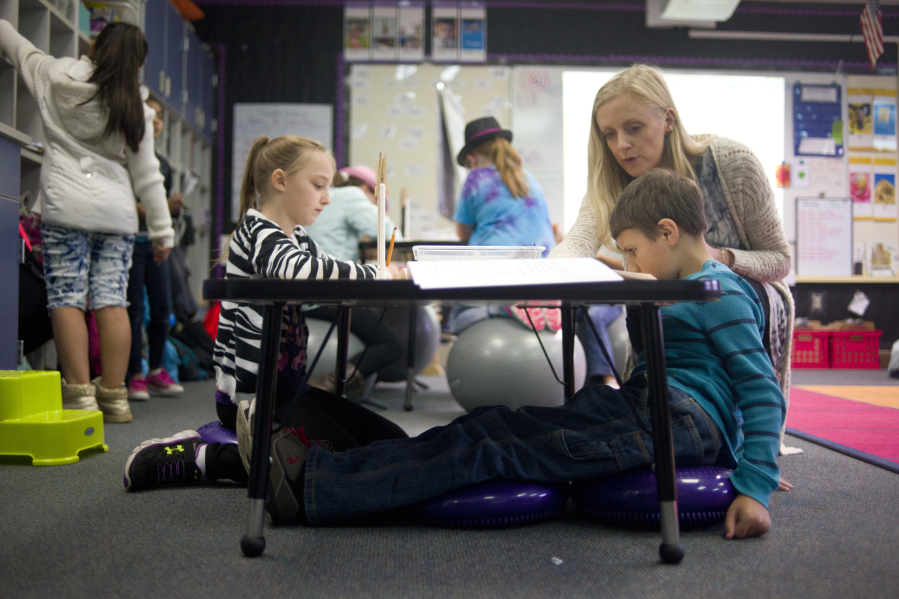WOODLAND — The lesson for Megan Lascik’s class on Tuesday was learning how to write a story by creating a character and setting, and her students excitedly broke up into smaller groups to bounce ideas off each other.
In the back of the room, a group of students giggled over naming their character Billy Bob Joe, while swaying back and forth in rocking chairs. A group of girls at another table bobbed up and down on yoga balls while working on the assignment.
It’s exactly what Lascik wants to see from her third-graders. This year, Lascik and Jennifer Crosby have brought flexible seating options to their third-grade classes at Woodland Intermediate School.
“It’s giving kids more ownership over their learning,” Crosby said. “It’s asking them to make a big decision every day.”
Crosby started researching flexible seating options last year, reading studies and blog posts from other teachers who have used them. She and Lascik went to the school toward the end of last year and asked about bringing different seating options to their classes. Their classrooms were set up with a variety of seating options.
The classrooms have yoga balls with pegs at the bottom, so they don’t roll away, wobble stools that allow the students to move in any direction, core discs that let the students sit or kneel on the floor, and plastic rocking chairs. Both teachers also allow students to sit or lie on carpet in the center of their classrooms.
“When the kids showed up on the first day of school and saw everything, their eyes were huge,” Crosby said. “They hadn’t seen a classroom set up like that before.”
Early in the year, both classes received a presentation from the school’s occupational therapist, who taught students what is called the “alert program,” in which students are asked to “be self-aware of their bodies,” Crosby said. The students rotated to each different seating style early in the year to get a feel for what they liked and were comfortable with. Now, the students pick how they want to sit at the start of each day. The students use the flexible seating options while working on individual or group work, and sit on a carpet in front of the teacher during the more instructional parts of the day.
“It’s fun to wobble while doing math instead of (sitting in) chairs,” said Faithe Moran, 8, who typically chooses a stool in Crosby’s class. “Chairs are boring.”
Ayla Peterson, 8, said she usually goes with a yoga ball, because it’s “fun to bounce.”
Ayla said that while the new seating styles are different, it makes class more exciting. Faithe said she likes the extra exercise.
“It’s made them more relaxed,” Crosby said. “It lets them get the wiggles out.”
Studies are starting to show that alternative seating methods might have a bigger impact than just in the classroom. Bringing more seating options into school can help make students healthier, according to various experts, such as Mark Benden, the department head of Environmental and Occupational Health and director of ergonomics at Texas A&M University in College Station, Texas.
In August, he co-authored a study published in the American Journal of Public Health that states that the use of standing desks can slow the increase in elementary school children’s body mass index, an indicator of obesity, by an average of 5 percent.
The study followed 193 students from the start of third grade through the end of fourth, spread across 24 classes, which were outfitted with standing desks with a foot rest and stool to allow students to sit or stand at will.
While he used standing desks in his study, Benden said the results aren’t necessarily about standing in class.
“This isn’t some sort of magic pill, but activity and movement in the classroom during schoolwork can have a big impact,” he said.
As part of the study, kids wore trackers, and those who used the standing desks took about 2,000 extra steps a day.
“That’s an extra five miles a week of walking, of movement,” Benden said.
“We’re not asking people to stand. We’re asking people to move. The standing desk is a proxy for movement.”
Benden said when kids are asked to sit still, it’s painful. As Crosby and Lascik have seen so far, allowing kids to move around can make them more comfortable in the classroom.
“There is a need for movement and it’s built in very young,” Benden said.
Flexible seating also can help accommodate students of all sizes.
“Classes don’t usually have adjustable furniture,” Benden said. “Why should they have to work with the same desk when they’re not all the same?”
Benden said there’s a long way to go before these types of seating options are widespread, but he’s seen public perception about them starting to shift in recent years. Lascik said it took very little time for her students to get on board with the new arrangement.
“We’ve started transitioning a little this year, and the kids are sad when they go to another class because they don’t have their special seating,” Lascik said. “I’ve had a few students ask if they could take it with them.”




